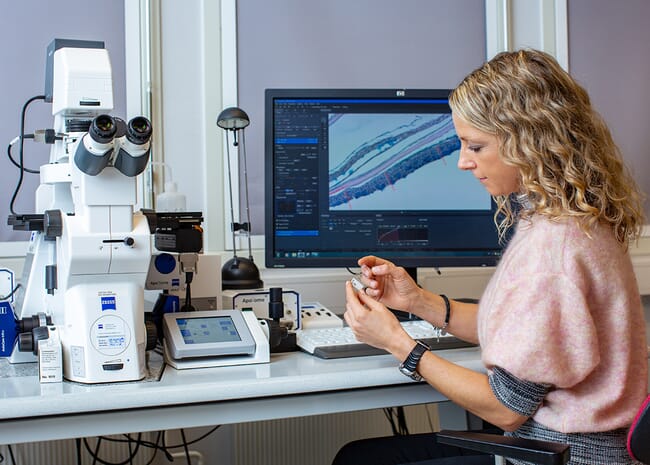Scientists at Nofima have conducted a project to evaluate how different levels of zinc and marine omega-3 fatty acids (EPA and DHA) in feed affect function, barrier properties and wound healing processes in salmon skin.

Skin, gills and intestines are part of fish’s first line of defence against stress factors in the environment. Fish skin provides chemical and physical protection against harmful substances in the water, including parasites, infectious diseases and particles. If the skin is not strong and intact, the fish’s protection is undermined. Fish skin consists of several layers that each help strengthen the skin and provide flexibility.
In the feeding experiment, five groups of salmon received feed with different levels of zinc and omega-3 ranging between 100 and 300 mg of zinc and 0.5 and 2 grams of omega-3 fatty acid per kilo of feed. These levels are above and below what is common in commercial salmon feed today.
The salmon were studied through smoltification in freshwater, transfer to salt water and ten weeks in salt water. The scientists wanted to study how zinc and omega-3 influenced the function, robustness and wound healing processes of the skin, using molecular and histological techniques.
The results of the experiment showed that the various layers are affected by the zinc and omega-3 levels in the feed.
Saltwater transfer
The fish that had received higher doses of omega-3 and zinc coped with the transfer to sea water better. While high levels of marine omega-3 strengthened the lower skin layers, through thicker connective tissue and fat layers, high levels of zinc affected the outer layers in that the outermost layer, the epidermis, became smoother and contained more mucous-producing cells. These differences seem to affect the fish’s skin strength and ability to withstand external stresses.
The scientists also saw this later in the experiment, when they studied wound healing ability. Wounds on fish that had received high levels of zinc and omega-3 in the feed healed faster than those on fish that had received lower levels. The wounds on the fish that had received the lowest levels of zinc and omega-3 healed slower.
Fish health scientist Elisabeth Ytteborg looks at how fish skin is affected by changes in the environment and finds it interesting to see how different nutrients can have positive effects when the fish is exposed to stress.
“In the experiment, we found that it was difficult to see any change in the fish when the environment was stable; however, when we challenged the fish in the form of salt water exposure or wounds, we could clearly see that the zinc and omega-3 levels in the feed have a major impact on the skin health of fish,” says Ytteborg.
Enough zinc is important for the skin health, and Ytteborg believes more research should be done on the effect of varying zinc and omega-3 levels in feed over time:
“Salmon would benefit from being prepped with zinc and omega-3 before they are transferred to seawater. The same may also apply before they are treated for lice, moved to cold water or other stressful event that we know can be challenging for skin health. However, we don’t know enough about this yet. There are strict restrictions on how much zinc can be used in salmon feed, but what we can continue working on is making the zinc that is allowed more accessible to the fish,” says Ytteborg.
There is an upper limit for zinc in fish feed, current EU regulations allow no more that 180 mg of zinc per kilo. Less than half of dietary zinc is absorbed by the fish, and the rest might reach harmful levels when emitted to the environment. Nofima is continuing its research on how salmon could use zinc more efficiently.
The project is financed by the Norwegian Seafood Research Fund (FHF).



